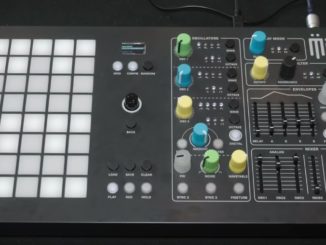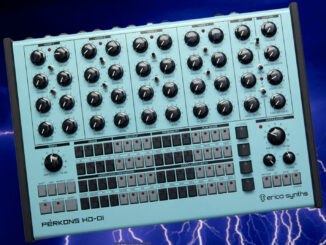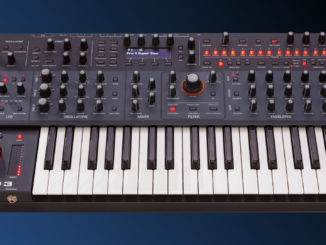Genki Katla is a new hybrid paraphonic Synthesizer with four oscillators that is inspired by Iceland’s subglacial volcano.
Synthesizers don’t grow out of the ground like trees. They are created by talented developers who are inspired by certain things. Many of them find their inspiration in past instruments or old/new technologies.
Genki, a company from Iceland known for its Wave Ring, has now developed a new Synthesizer. The developers found inspiration not in classic synths like the Minimoog but in Iceland’s subglacial volcano.
Genki Katla
Katla is a new paraphonic Synthesizer from Iceland. According to the Genki developers, it uses a “digilog” engine, i.e., digital and analog, better known as a hybrid. Important note: the website doesn’t yet provide much information about synth. There are, however, pictures that show the user interface.
The interface shows four oscillators with controls over the level and octave but no controls for the oscillators. Next to this, it has buttons for the sub-oscillator. There is also a noise generator and a wave folder.
You can also see several play modes for the synth on the interface, including mono, duophonic/paraphonic, and quad. Plus, there are round-robin and unison modes.
Then, the Genki Katla filter section is analog and features both resonant lowpass and highpass settings with modulation. Interestingly, the lowpass filter has the biggest knob of the synth and offers selectable WASP and MS-20 modes. From here, the signal goes into a multi-FX section consisting of a chorus, an overdrive, and a real spring reverb.
The position of the spring reverb is wild. The appropriate springs are attached to the front panel, which invites you to interact with them.
Effects & Modulation
Modulation is also onboard. Genki Katla has two envelopes, one for the amp and another freely routable to the filter, pitch, or FX. Further, it includes a multi-wave LFO with rate control and multiple targets (pitch, LPF…) and a sample & hold option.
Aftertouch is also onboard, which is routable to the oscillator detune, lowpass filter, and a mysterious Katla parameter. Yes, Genki Katala has built-in patch storage. The synth does not have a screen but many buttons on the left to recall patches.
There is currently no sound demo of the Katala. Genki describes the sound as follows:
“KATLA’s digilog sound engine mimics the crackling of lava, rumble of seismic activity, and eerie silence of the glacier above.
First Impression
At first glance, it is a very wild, unusual hybrid synth. I can’t say much about the synth now, as there are no sound demos. I’m pretty sure it’s a very niche and premium synth for a little target group. Check the price tag, and you will understand it.
Genki Katla is now available for pre-order for 4990€, and batches are limited to 30 units.
More information here: Genki






Lol, just seen the price. For a paraphonic synth.
Just.
Wow.
I can buy a new ducati scrambler and 3 behringers for that.lol
“The Devil Wears Lava”
I don’t think this is for people who buy Behringer. I think someone who’d buy this would probably just pick up the phone and call them, maybe even come over to try it out.
I wouldn’t throw down this cash mostly because I don’t have it and subsequently I don’t use hardware much.
I love affordable gear, but I don’t think its reasonable to expect all gear to be affordable.
Since these are my countrymen (I don’t know them but lots of friends used the Genki Wave) I’m a bit sad that all the comments are sneering and negative.
And they all have very little insight. The crazy price is pretty obvious and doesn’t really need to be said 14 times.
But given the very limited marketing info the company offered, maybe that’s not so surprising. The premise is interesting but they don’t describe it.
Ridiculous isn’t it
“Inspired by Iceland’s subglacial volcano…”
“Digilog engine”
“Crackling of lava, rumble of seismic activity, and eerie silence of the glacier above.” (I’m super excited about how the “silence” sounds, btw.)
No info, no sound examples.
Asking price.
There are so many red flags, I might as well be playing Minesweeper.
Buy a plane ticket and a pro field recorder setup for about half, and go visit / record that volcano for real in all its stereophonic glory. That’s money well spend!
Sounds like a plan!
Some people will buy just because it’s limited but for 5K I’d really want to know what I was buying, what makes it worth the cash, what different about it, and more importantly many more sound demo’s.
Selling my limited set of peanuts, looking like synths (somewhat), btw. Asking price: I don’t know? “Alexa, give me a random integer and add a three or four zeros”.
5K€$£? for a synthesizer with “different” sounds don’t fool me.
“Sounds” from the nonsensical marketing that this is a “cheap” digilog sample playback digital oscillator with analogue filters in a very handsome package for $5K! And I have no issues with digital oscillators however if it was an FPGA, then I might have been a bit more impressed. And for those of you non familiar with Genki, they are desperately trying to be a less useful Teenage Engineering.
Ah, they did the Wave Ring. Which was as useful, as Roli’s new “cast a magic spell to cutoff your filter with your hand” thingy – another ‘game changer” according to Synthtube. I agree on what you said, except for the price, I could demand a display, maybe (handsome package). But since TE does them even with their POs and Genki is less useful (totally agree) I guess I should just cope with hands on controls like it’s 1970. But hey, it’s a Limited Edition. These are expensive, aren’t they.
I completely agree, a screen-less synth in this day and age is a nonstarter for me! I implored the duo at Synthstrom for years to implement a better screen, they claimed repeatedly that the idea was to use ones ears. Apparently, there are those whom can’t employ both. And then I even offered to assist in the implementation without charge, they again claimed that the alpha numeric screen was sufficient. Now of course it has a led screen.
The Genki is handsome and regardless of the sound, it is terribly overpriced.
Listen! It’s only 5k and it sounds like nothing you’ve heard before at this price point.
Unless you’ve received a synth that was DOA.
Seriosly what kind of shitty marketing bs is this? Or is this pre hype? Count me out.